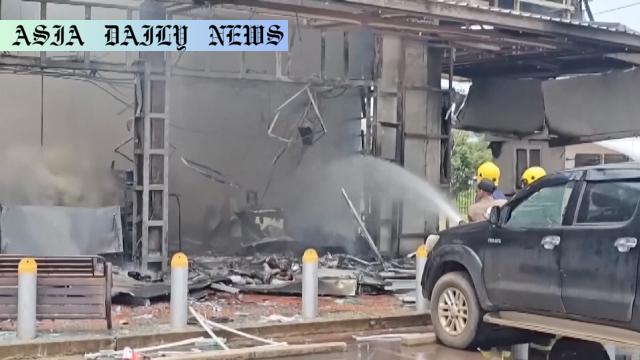Ceasefire discussions between Thailand and Cambodia continue as agreements aim to stabilize tensions in the disputed border region.
- Ceasefire agreements aim to manage tensions in the Cambodia-Thailand border region.
- Proposal for a third-party monitoring team involving ASEAN and other stakeholders.
- Discussions include Cambodian troop repatriation conditions.

Introduction: Ceasefire Negotiations Pave a New Path
Thailand and Cambodia have initiated significant discussions, fostering new hope for resolving their ongoing disputes. The recent outbreak of violence in a contentious border region led to over 40 casualties. The conflict, starting on July 24, created an urgent need for diplomatic intervention. Last week’s ceasefire negotiations, facilitated by Malaysia as ASEAN’s 2023 chair, marked an essential milestone. Current talks in Malaysia aim to solidify this ceasefire and prevent future escalations.
Third-Party Monitoring: Strengthening the Agreement
A major focus of these discussions lies in creating a neutral entity to observe and manage the ceasefire terms. ASEAN members, along with potential global stakeholders, are being considered for inclusion in this third-party monitoring team. This proposal signifies a commitment from both nations to uphold their agreement, providing an unbiased system to ensure both sides remain compliant with the ceasefire terms. Such a step is essential in fostering mutual trust amidst existing tensions.
The Dilemma of Detained Troops
One of the contentious topics in the negotiations is the release of 18 Cambodian troops held by Thailand. Bangkok has made it clear that their return is contingent upon a complete cessation of hostilities, emphasizing its demand for long-term peace before addressing the issue. On the other hand, Phnom Penh has been vocal in demanding the early return of its detained soldiers, considering it a gesture of goodwill. This impasse underscores the delicacy required to resolve not only the broader conflict but also the individual elements fueling tension.
Upcoming High-Level Talks: A Collaborative Hope
The concluding day of talks is expected to bring defense ministers from Thailand and Cambodia together, alongside global representatives, including officials from the United States and China. The presence of influential international stakeholders like these reflects the global importance of maintaining stability in the region. Their participation could provide additional perspectives and solutions, ensuring that the ceasefire agreement extends beyond temporary peacekeeping measures to create sustainable stability.
Challenges and Opportunities Ahead
Despite the ceasefire agreement, tensions remain palpable between the two nations. Both governments have exchanged verbal accusations since the deal. Resolving decades-long disputes over territorial claims, ensuring transparent border demarcations, and paving the way for positive bilateral relations will require trust, patience, and proactive diplomacy. ASEAN’s involvement, in partnership with third parties, could leverage its regional authority and further promote peaceful dialogues.
Conclusion: Positive Progress Requires Coherent Actions
These negotiations between Thailand and Cambodia build a foundation of hope for addressing broader geopolitical tensions around ASEAN borders. The inclusion of ASEAN and international third parties, along with focused discussions on troop repatriation and international engagement, could pave the way for a stronger, more peaceful region. Positive progress is evident but sustaining this trajectory will demand continued cooperation, an unwavering commitment to transparency, and adherence to shared goals.



Commentary
Reflecting on the Ceasefire Agreement
The ongoing ceasefire negotiations between Thailand and Cambodia are noteworthy, not only for the nations involved but also for the wider ASEAN region and global stakeholders. Conflict resolution in contentious border regions requires strategic collaboration, and the inclusion of a third-party monitoring framework underscores a commitment to lasting peace. This step should be viewed as a testament to ASEAN’s role as a peace-building entity.
The Importance of Neutral Oversight
Neutrality in conflict resolution offers a unique advantage, especially when regional tensions are high. The involvement of ASEAN and third-party stakeholders in monitoring the ceasefire ensures impartiality while also fostering accountability. Trust is often the first casualty in conflict situations, and adopting such a transparent mechanism might be the key to rebuilding this fragile yet critical element.
Troop Repatriation as a Goodwill Gesture
The issue of detained Cambodian troops highlights the delicate balancing act required during peace negotiations. While Thailand emphasizes complete cessation before their release, the early return of troops could serve as a confidence-building measure. Such initiatives showcase the intent to move past hostilities and establish grounds for future bilateral cooperation. However, achieving this balance requires empathetic negotiation from both sides.
The Role of Global Stakeholders
The inclusion of the United States and China in high-level talks reflects the significance of the situation. Their vested interests in Southeast Asian stability and economic progress make them active players in shaping the outcome. By providing alternate viewpoints and possible solutions, these stakeholders can offer additional pathways to achieving lasting peace.
Final Reflections
The Thailand-Cambodia ceasefire dialogue exemplifies how regional disputes can be addressed through collaborative diplomacy, multilateral engagement, and adherence to shared values. It is a critical moment for both nations to rise above historical grievances and build a precedent for peaceful conflict resolution. The coming days will test their resolve and set the tone for ASEAN’s role in addressing future regional challenges.